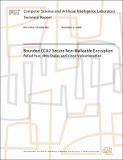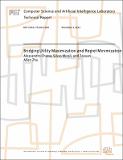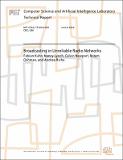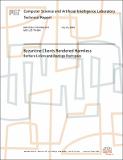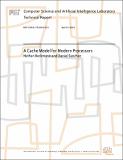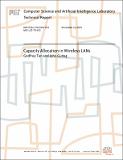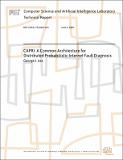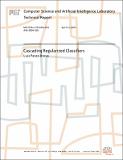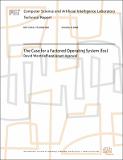Browsing CSAIL Digital Archive by Title
Now showing items 116-135 of 806
-
Bounded CCA2-Secure Non-Malleable Encryption
(2006-12-14)Under an adaptive chosen ciphertext attack (CCA2), the security of an encryption scheme must hold against adversaries that have access to a decryption oracle. We consider a weakening of CCA2 security, wherein security ... -
Bounded-Contention Coding for Wireless Networks in the High SNR Regime
(2012-08-27)Efficient communication in wireless networks is typically challenged by the possibility of interference among several transmitting nodes. Much important research has been invested in decreasing the number of collisions in ... -
Bridging Theory and Practice in Cache Replacement
(2015-12-19)Much prior work has studied processor cache replacement policies, but a large gap remains between theory and practice. The optimal policy (MIN) requires unobtainable knowledge of the future, and prior theoretically-grounded ... -
Bridging Utility Maximization and Regret Minimization
(2013-12-03)We relate the strategies obtained by (1) utility maximizers who use regret to refine their set of undominated strategies, and (2) regret minimizers who use weak domination to refine their sets of regret-minimizing strategies. -
Broadcasting in Unreliable Radio Networks
(2010-06-08)Practitioners agree that unreliable links, which fluctuate between working and not working, are an important characteristic of wireless networks. In contrast, most theoretical models of radio networks fix a static set of ... -
Bucket Elimination Algorithm for Dynamic Controllability Checking of Simple Temporal Networks with Uncertainty
(2021-03-02)Simple Temporal Networks with Uncertainty (STNU) can represent temporal problems where duration between events may be uncontrollable, e.g. when the event is caused by nature. An STNU is dynamically controllable (DC) if it ... -
Building Grounded Abstractions for Artificial Intelligence Programming
(2004-06-16)Most Artificial Intelligence (AI) work can be characterized as either ``high-level'' (e.g., logical, symbolic) or ``low-level'' (e.g., connectionist networks, behavior-based robotics). Each approach suffers from particular ... -
Building Spatial Computers
(2007-03-14)Programmability is a major challenge in spatial computing, anaggregate control problem found in domains such as sensor networks,swarm robotics, and modular robotics. We address this challenge witha model of a spatial ... -
Byzantine Clients Rendered Harmless
(2005-07-21)Byzantine quorum systems have been proposed that work properly even when up to f replicas fail arbitrarily.However, these systems are not so successful when confronted with Byzantine faulty clients. This paper presents ... -
Byzantine Fault Tolerance in Long-Lived Systems
(2004-08-13)This paper proposes counter-measures that can be deployedas part of a replicated system to reduce the size ofW, and thus reduce the class of attacks to which the system is vulnerable. Obviously it will not be possible to ... -
Cabernet: A Content Delivery Network for Moving Vehicles
(2008-01-17)This paper describes the design, implementation, and evaluation of Cabernet, a system to deliver data to and from moving vehicles using open 802.11 (WiFi) access points encountered opportunistically during travel. Network ... -
Cache Calculus: Modeling Caches through Differential Equations
(2015-12-19)Caches are critical to performance, yet their behavior is hard to understand and model. In particular, prior work does not provide closed-form solutions of cache performance, i.e. simple expressions for the miss rate of a ... -
A Cache Model for Modern Processors
(2015-04-09)Modern processors use high-performance cache replacement policies that outperform traditional alternatives like least-recently used (LRU). Unfortunately, current cache models use stack distances to predict LRU or its ... -
Can Basic ML Techniques Illuminate Rateless Erasure Codes?
(2004-05-05)The recently developed rateless erasure codes are a near-optimal channel coding technique that guaranteeslow overhead and fast decoding. The underlying theory, and current implementations, of thesecodes assume that a network ... -
Capacity Allocation in Wireless LANs
(2004-11-12)Today's access point based wireless LANs (WLANs) are inefficient and unfair. For many traffic loads they provide far less total throughput than they should, and do a poor job allocating what throughput they do deliver. ... -
CAPRI: A Common Architecture for Distributed Probabilistic Internet Fault Diagnosis
(2007-06-04)This thesis presents a new approach to root cause localization and fault diagnosis in the Internet based on a Common Architecture for Probabilistic Reasoning in the Internet (CAPRI) in which distributed, heterogeneous ... -
Cascading Regularized Classifiers
(2004-04-21)Among the various methods to combine classifiers, Boosting was originally thought as an stratagem to cascade pairs of classifiers through their disagreement. I recover the same idea from the work of Niyogi et al. to show ... -
The Case for a Factored Operating System (fos)
(2008-10-08)The next decade will afford us computer chips with 1,000 - 10,000 cores on a single piece of silicon. Contemporary operating systems have been designed to operate on a single core or small number of cores and hence are not ... -
A Case for Fine-Grain Adaptive Cache Coherence
(2012-05-22)As transistor density continues to grow geometrically, processor manufacturers are already able to place a hundred cores on a chip (e.g., Tilera TILE-Gx 100), with massive multicore chips on the horizon. Programmers now ... -
CG2Real: Improving the Realism of Computer Generated Images using a Large Collection of Photographs
(2009-07-15)Computer Graphics (CG) has achieved a high level of realism, producing strikingly vivid images. This realism, however, comes at the cost of long and often expensive manual modeling, and most often humans can still distinguish ...

